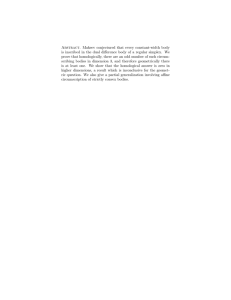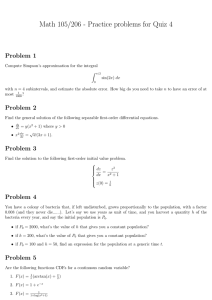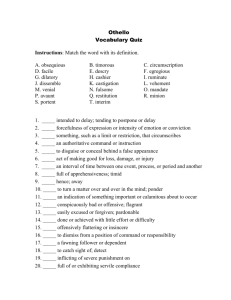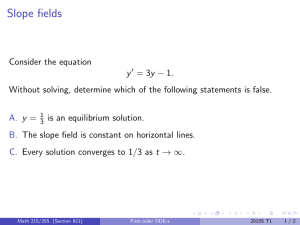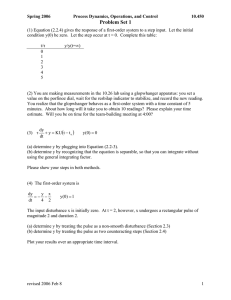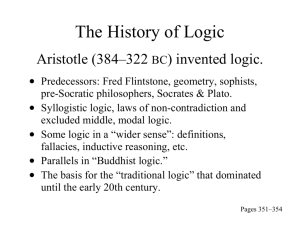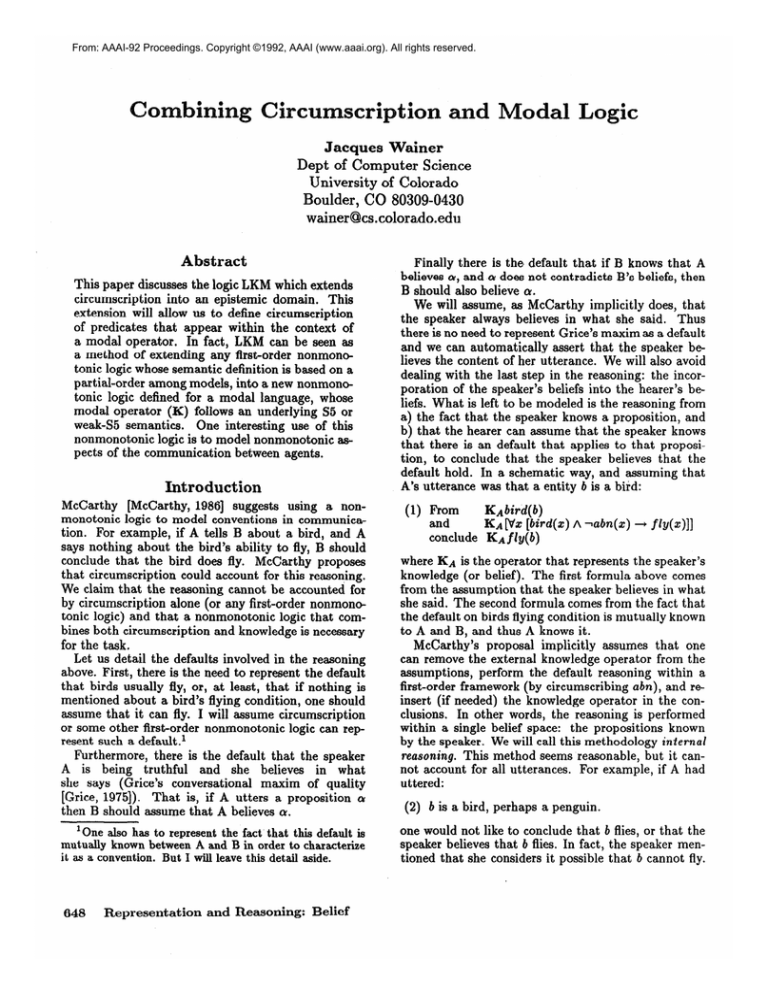
From: AAAI-92 Proceedings. Copyright ©1992, AAAI (www.aaai.org). All rights reserved.
odal Logic
g Circ
Jacques Wainer
Dept of Computer Science
University of Colorado
Boulder, CO 80309-0430
wainer@cs.colorado.edu
Abstract
This paper discusses the logic LKM which extends
circumscription into an epistemic domain. This
extension will allow us to define circumscription
of predicates that appear within the context of
a modal operator. In fact, LKM can be seen as
a method of extending any first-order nonmonotonic logic whose semantic definition is based on a
partial-order among models, into a new nonmonotonic logic defined for a modal language, whose
modal operator (K) follows an underlying S5 or
weak-S5 semantics. One interesting use of this
nonmonotonic logic is to model nonmonotonic aspects of the communication between agents.
Introduction
McCarthy [McCarthy, 19861 suggests using a nonmonotonic logic to model conventions in communication. For example, if A tells B about a bird, and A
says nothing about the bird’s ability to fly, B should
conclude that the bird does fly. McCarthy proposes
that circumscription could account for this reasoning.
We claim that the reasoning cannot be accounted for
by circumscription alone (or any first-order nonmonotonic logic) and that a nonmonotonic logic that combines both circumscription and knowledge is necessary
for the task.
Let us detail the defaults involved in the reasoning
above. First, there is the need to represent the default
that birds usually fly, or, at least, that if nothing is
mentioned about a bird’s flying condition, one should
assume that it can fly. I will assume circumscription
or some other first-order nonmonotonic logic can represent such a defau1t.l
Furthermore, there is the default that the speaker
A is being truthful and she believes in what
she says (Grice’s conversational maxim of quality
[Grice, 19751). That is, if A utters a proposition Q!
then B should assume that A believes o.
‘One also has to represent the fact that this default is
mutually known between A and B in order to characterize
it as a convention. But I will leave this detail aside.
648
Representation
and Reasoning:
Belief
Finally there is the default that if B knows that A
believes o, and CI!does not contradicts B’s beliefs, then
B should also believe cy.
We will assume, as McCarthy implicitly does, that
the speaker always believes in what she said. Thus
there is no need to represent Grice’s maxim as a default
and we can automatically assert that the speaker believes the content of her utterance. We will also avoid
dealing with the last step in the reasoning: the incorporation of the speaker’s beliefs into the hearer’s beliefs. What is left to be modeled is the reasoning from
a) the fact that the speaker knows a proposition, and
b) that the hearer can assume that the speaker knows
that there is an default that applies to that proposition, to conclude that the speaker believes that the
default hold. In a schematic way, and assuming that
A’s utterance was that a entity b is a bird:
KA bird( b)
(1) From
and
KA pz [bird(z) A labn(z)
conclude KA fly(b)
-
fly(z)]]
where KA is the operator that represents the speaker’s
knowledge (or belief). The first formula above comes
from the assumption that the speaker believes in what
she said. The second formula comes from the fact that
the default on birds flying condition is mutually known
to A and B, and thus A knows it.
McCarthy’s proposal implicitly assumes that one
can remove the external knowledge operator from the
assumptions, perform the default reasoning within a
first-order framework (by circumscribing abn), and reinsert (if needed) the knowledge operator in the conclusions. In other words, the reasoning is performed
within a single belief space: the propositions known
by the speaker. We will call this methodology internal
reasoning. This method seems reasonable, but it cannot account for all utterances. For example, if A had
uttered:
(2) b is a bird, perhaps a penguin.
one would not like to conclude that b flies, or that the
speaker believes that b flies. In fact, the speaker mentioned that she considers it possible that b cannot fly.
We will call utterances like (2) as epistemic cuncellations. Epistemic cancellations are expressions where
an epistemic possibility construct is used to cancel a
default. Or more specifically, by using epistemic cancellation the speaker is informing the hearer that a particular default proposition should not be attributed to
her. Epistemic cancellations also occur in the domain
of generalized implicatures wainer , 199 11.
For the utterance above, internal reasoning will not
work. The problem is that the result of removing the
external knowledge operator will not be a first-order
formula, but a formula that contain a modal operator,
that is:
(3)
bird(b) A Ppenguin(b)2
In this case, it will not be possible to circumscribe
abn because circumscription is not defined for modal
formulas.
This paper will propose a way of extending circumscription so that the reasoning described in (1) can be
performed with the K operators in place, as opposed
to the internal reasoning method. The logic will allow for the circumscription of predicates that appear
in modal formulas and will be able to deal correctly
with examples like (2).
This extension of circumscription to modal domains
will be accomplished by semantic means.
A large
family of first-order nonmonotonic logics, which includes circumscription, are semantically defined by
a partial order “5” among models [Lifschitz, 1985,
Shoham, 19871. For these logics, entailment is defined
as satisfiability by the set of s-minimal models as in
(4).
(4) a I=5 P
iff
Wf E G(a),
M I= P
In the definition above, /= is the standard first-order
satisfiability operator, and I’l(cw) is the set of all Iminimal models that satisfy cy, or formally:
(5)
I-,(a) = (A4 E r&Y)
Il3M’
E I+)
N’ < Al}3
where the set I’c(cr) is the set of all models that satisfy
Cy:
(6)row = w I MI=4
The logic LKM (after “Logic of Knowledge and Minimization”) described in this paper is a method of
defining a new partial order “5” among modal-models
based on the ordering 5 among first-order models. The
definition of entailment in LKM is the same as (4) but
where the set I’1(ar) is defined in terms of “C” instead
of “5.” In fact, nothing on the definition of LKM
hinges on the fact that ,< is the partial order defined
2The operator P for epistemic possibility, is the dual
of K. From now on we will use K as the speaker’s belief
operator.
for some form of circumscription. Any first-order nonmonotonic logic whose semantic is based on partial order can be extended to a corresponding LKM logic.
The next section will discuss the definition of the
partial-order & and show that it correctly extends ,<
to an epistemic domain.
Semantics of L
The language of LKM is that of a modal logic with
quantification and equality, where the modal operator
is K. There are no restrictions to the relative scope of
quantifiers and the modal operator, and in particular
quantifying into a modal context is allowed.
The propositional aspect of the semantics of the K
operator should follow the S5 or weak-S5 semantics,
and therefore the K operator refers to the knowledge
of a perfect reasoner, with both positive and negative
introspection.
In particular, because the underlying
propositional modal logic is weak-S5 or S5, instead of
using an accessibility relation among possible worlds
[Halpern and Moses, 19851 one can talk about a set of
possible worlds, each one accessible to the others.4 The
difference between S5 and weak-S5 is whether the real
world belongs or not to this set of mutually accessible
possible-worlds.
Before discussing the formal aspects of the semantics for LKM, I will discuss some of the intuitive ideas
behind these definitions.
Intuitive view
There are two main ideas in defining the semantics of
LKM. The first idea is that a possible world, as defined
for the semantics of modal logics, can be seen as a first
order model, and thus the 5 relation can be used to
order possible worlds.
In propositional modal logics semantics, a possible
world is just an index for the interpretation function
([Halpern and Moses, 19851 for example). For example, the truth value of a propositional symbol p in a
possible world 201, is the value assigned to it by the
interpretation function, at index wl. If I is the interpretation function, then the truth value of the propositional symbol p in the world 201is I(wi , p). The idea of
possible-worlds as index is also used in the semantics of
quantified modal logics [Garson, 1983, Wainer, 19881.
But there is another view of possible worlds, one that
agrees more with the intuitions behind the whole idea
of possible-world semantics: each possible world can
be seen a first-order model. A first-order model, in
this context, is any structure that assigns consistent
truth values to all first-order formulas of a language
(formulas with no modal operators). In more details,
a first-order model is a structure that assigns to each
term in the language an object, to each unary predicate symbol a set of objects, and so on, and finally
*This point is also made in [Levesque, 19901.
Wainer
649
assigns truth value for each formula in the language
according to the usual recursive rules.
Formally, this view of possible-world as a first-order
model can be easily accomplished by incorporating the
interpretation function into the possible world itself.
In the index view of possible-worlds I(uti , (u) denotes
the truth value of CYin world 201. In the first-order
model view, one defines the function Aa: I(wi, Z) and
call it the possible-world ~1. Now, at each possible
world, one can determine the truth value of all firstorder formulas. This corresponds more closely to the
philosophical intuitions of possible-words as “alternative realities,” each one with its own domain and true
propositions.
Under this view of possible worlds, it
is possible to use the relation 5 to compare possible
worlds across different modal models.
A modal model, under this view, is a 2-tuple M =
(wc, IV), where 200 is a possible-world called the real
world, and IV is a set of possible worlds. There is no
need to define an interpretation function since all possible worlds are themselves interpretation functions.
The second idea is that of an elementary improvement between two different modal models. The elementary improvement relation uses this ability of comparing possible-worlds of different modal models using
5 to define a relation among modal models.
A model Ml = (wcl, WI) is an elementary improvement of M2 = (wo2, W2) if the sets Wi and IV2 agree
in all but a pair of possible worlds, one in each set.
And the differing possible world that belongs to Wi is
“smaller” (in the 5 sense) than its correspondent in
Wz. In an informal language, if one sees the formula
wi < w2 as stating that wr is “smaller” then ~2, then
Ml % an elementary improvement of M2 if exactly one
possible world in M-J got “smaller” in Ml.
The elementary improvement relation is the bridge
between the partial order 5 among first-order models,
and the relation & among modal models (which will be
defined as the transitive closure of the elementary improvement). Informally, a modal model Ml is “better”
(in the 5 sense) than M2 if at least one world in Ml
is “smaller” (in the 5 sense) than its correspondent in
M2 .5 In fact, the definition of elementary improvement
is necessary in order to formalize what “correspondent”
means.
The definition of a model M for a LKM formula is:
51nformally, I use the term “smaller” when comparing
possible-worlds using the relation 5, and I use the term
“better” when comparing modal models under the relation
&. This is also the intuition underlying the name “element ary improvement .))
Representation
0 all terms in the language denote the same object in each possible-worlds in the model.
The requirement of rigid designators seems appropriate when describing the knowledge state of a single
agent (in this case the speaker), but is too restrictive
when relating the knowledge of two different agents,
or relating the knowledge of an agent to the reality
[Maida, 199 11.
We can now define satisfiability for LKM, in the
usual way:
(w,W) ka
iff
w ~FOL CYwhere Q contains no modal operators and “blot”
is the
standard first-order satisfiability
(w,W)
~CEA@
iff
(w,W)
/=cu and
b%W) l=P
(w, W) f= -a
iff
(w, IV) k cy
there exist an object o
(w, W) b 33x2 iff
in the domain of w and (w, W) b og6
(w, W) b KCY iff
(w’, w> I= *
for all w’ E W
We now define the elementary improvement rela“ge” between two models Ml = (WI, WI) and
tion
=
(w2W2).
(10) Ml C, MS
iff
= W2 or
Wl - w2 = {wa) and W2 - WI = {wb}
and w, 5 wb or
Wl - w2 = 0 and W2 - WI = {wb}
and there is wC E WI and wc 5 wb
Wl
M = (~0, W)
where we is called the recsl world, and W is a set of
possible worlds.
650
(8) e all possible-worlds in the model have the same
domain.
M2
Formal definitions
(7)
The logic LKM itself places little constraints on the
semantic of terms. So far, the only requirement is that
each possible-world should be a first-order model, so
that possible-worlds can be compared using the 5 relation. This means that all terms in the language must
have a denotation in each possible-world. This rules
out some quantified modal logics where a term may not
have a denotation in some possible-worlds in a model
(see [Garson, 1983, Wainer, 19881). But, to be able
to prove the theorem in the next section, which states
that the logic LKM based on the relation C is indeed an
extension of the first-order nonmonoton:
logic based
on 5, one need further constraints. We will assume the
stronger set of constraints for the semantic of terms,
that is that all terms are rigid designators. This means
that for each model:
and Reasoning:
Relief
6 “~5” is the formula cy where all instances of 2: has been
substituted by o. This introduces the new concept of formulas that contain references to objects of the model, but
this can be dealt with in a natural way [Waker, 19881.
In other words, Ml is “better” then MS, if a) they have
the same set of accessible worlds, or b) the sets differ
by one world each, and the differing world in Ml is
“smaller” then the correspondent world in MS, or c)
Ml has a world less then M2, and the extra world in
M2 is not minimal.
The relation & among modal models is defined as
the transitive closure of C_,.
Finally, one defines entailment as described in (4).
We first define two auxiliary sets A0 (the set of all
models that satisfy a formula) and Ai (the set of all
E-minimal models of IO):
Under the view of possible-worlds as first-order models,
all first-order models can be seen as a possible-word
and vice versa. Then, the proof of (16) is simple: the
set Us, (a) correspond to the set Ii(o) in the definition
of l=gl in (4).
Formula (16) is the bridge between the first-order
nonmonotonic logic defined by j=s, and the logic
LKM. The rest of the proof is done within the semantics of LKM itself. What is left to show is:
(11) A,(a)
To prove that, one has to show that:
Al(o)
= {M I M I= a}
= {M E AO(CY)] GIM’ E no(a)
M’cM)
and
and define entailment based on those sets:
(12)
Q!l=~ P iff VM E AI(~), M I=P
This completes the definition of the logic LKM.
.A rnetalogical result
We can prove that the logic LKM (based on the relation 51) is an extension of the corresponding first-order
nonmonotonic logic (based on the relation 51). We will
prove that if 0 entails p in the first-order (nonmonotonic) logic defined by 51, then Kcu will entail KP in
LKM (with partial relation &I). Or, formally:
(13) a I=<, P
iff
* I=5 w
where cv and p are first-order formulas.
The claim above proves that any example of a phenomenon that is correctly modeled by using a firstorder nonmonotonic logic and internal reasoning, will
be correctly modeled by the LKM extension of that
logic. And hopefully, LKM will also correctly model
other examples for which internal reasoning cannot be
applied, for example epistemic cancellations. In particular we will show in the next section of this paper
that a LKM extension of prioritized circumscription
will correctly model inheritance reasoning for epistemic
cancellation examples.
Prcoof We will present the sketch of the proof of (13).
The full proof can be found in [Wainer, 19911. The first
step of the proof is to collect all possible-worlds that
satisfy o in a single set Uo(cr). That is,
(14) Uo(Q) = {u’ I (w,@) l= a)
where “b” is satisfiability in the logic LKM and 0 is
the empty set.
The set u< 1(o) collects all si-minimal models of
Uo(Q).
(15)
U<,(cr)
=
{w
E Uo(cy)
1 +lw’
The next step is to prove that:
E Uo(a),
W’<lW)
(16)
a l=rl P
iff
VWE &(4,
(w, 0) I= P
07)VW
Eu&4 (w,S>
I=P iff I& j=c,W
(18) M E A(o)
iff
M = (z, W) and W
and M satisfy the constraints in (8).
c v<IW
where 2 is any possible world. That can be easily accomplished by a proof by contradiction for each direction of the biconditional. This completes the proof of
(13).
Applications of the logic LKM
The logic LKM seems suitable to be used in modeling some defeasible communication phenomena.
In
specific, if a first-order nonmonotonic is suitable to
model a defeasible phenomenon, the LKM extension of
that logic will allow the model to deal with epistemic
cancellations. For example, [Wainer, 19911 uses LKM
to model generalized implicatures in natural language
understanding.
In that work, generalized implicatures (which can be understood as a non-conventional
form of ambiguity that is derived from communicative
principles--G rice’s maxims [&ice, 19751) are treated
essentially as the preferred meaning of some linguistic
expression, and circumscription is used to make this
preferred meaning the default meaning of the expression. The use of LKM allows the model to account for
epistemic cancellation expressions, that is sentences of
the form (2). D ue to space constraints we will not
further describe this model. But since the main use
of LKM in that model is to account for of epistemic
cancellations we will instead show that the logic does
capture the correct conclusions of these expressions.
An example
Let us go back to the utterance (2) and let us assume
the following axioms:
(19) Iqvl: bird(s) A lab?+)
+ fly(z)]
KPJx penguin(x) 3 bird(x)]
Kpx penguin(x) A wh2(x)
---)-fly(x)]
which are the standard circumscription implementation of the penguin/bird defaults, except that the
formulas refer to the speaker’s knowledge of the defaults. To obtain the defaults (for the formulas without
the knowledge operator) one should circumscribe both
Wainer
651
abnl and abnz, giving abnz a higher priority. For simplification let us assume that all other predicates are
allowed to vary. This circumscription policy defines a
first-order partial order, denoted as SC, as follows:
domain
= domain(w2)
and
l~bmlwl c labn21wl or
bbmlwl = lab&,
and labnllwl c IabnllWa
In the formulas above the expression Iabn21W, denotes
the extension of the predicate abn2 in the first-order
model (or possible world) ‘~1.
The statement that the speaker believes in the semantic content of (2) is:
(21) K[bird(b)
A Ppenguin(b)]
which is equivalent to (22).
(22) Kbird(b)
A Ppenguin(b)7
Let us determine what is entailed by applying the
circumscription policy above to the conjunction of (19)
and (22). Given a model M = (we, W) that satisfies
the conjunction of (22) and (19), each possible-world
in W satisfies the formulas in (19) without the external
knowledge operator, and also satisfies bird(b), and at
least one possible-world in W satisfies penguin(b).
The set W can be divided into two nonintersecting
A2 =sets
( EAlw =, 1; pc g” I;)&- hpenguin(b)I and
W
20
en uin
, w ere at least Al is
not empty. Let us now consider the sets Bi and B2 of
the <,-minimal worlds in A1 and A2 respectively. The
worlds in Bi assign the singleton {b} to the extension
of abnl and assign the empty set to the extension of
abn2, and the worlds in B2 assign the empty set to
both extensions.
The set of models of the form M’ = (we, B1 U &)
is exactly the set of all CC-minimal models. That is, a
model of the form M’ = (pus,B1 U B2) satisfies the
conjunction of (19) and (22) and none of its possible worlds can be “improved upon.” Thus every lZ,minimal model satisfies (23) which seems to be the
correct conclusion to derive from the utterance (2).
(23) K[penguin(b) A -fly(b)
V
bird(b) A ypenguin(b)
A f Zy(b)]
Related work
Lin [Lin, 19881 a1so combines circumscription and
modal logic but with very different goals. The work
shows that a form of minimal-knowledge logic can be
obtained by “circumscribing” the knowledge operator
in a propositional modal logic. The circumscription of
the knowledge operator is defined as a syntactic analog
7KPp c-) Pp is a tautology in S5 and weak-S5.
652
Representation
and Reasoning:
Belief
of the circumscription formula for predicate circumscription. Thus, Lin’s work differs from the research
reported in this paper in both goals and methodology.
Lifschitz’s work on introspective circumscription
[Lifschitz, 19891 is also related with this research. Lifschitz’s goal is to extend circumscription to include
the equivalent of non-normal defaults. This is done by
defining for each predicate symbol Pi an auxiliary predicate symbol L-P’ which is interpreted as epistemic. In
other words, L-Pi( c ) is interpreted as meaning that c is
known to have the Pi property. Introspective circumscription provides a syntactic and semantic definition
for the extension of L-Pi.
It is important to notice that introspective circumscription is a non-modal logic, and the concept of
“known” there is very different from the concept of
knowledge in modal logics, and therefore in LKM.
In fact, “known” in introspective circumscription is
closely related with the concept of “being identified
as having the property.” If c is a term in the language,
the formula L-Pi(c) will be true if and only if the entity denoted by c is in the circumscribed extension of
Pi. Thus, if one circumscribes the predicate P in the
theory 3oP(x) the extension of P contains only one
entity, but the extension of L-P is empty since no specific entity can be proven to belong to the extension of
P.
In some ways, LKM and introspective circumscription can be seen as complementary efforts. Introspective circumscription is interested in defining what is the
circumscription of the predicate expression AzK P( z)
given some (first-order) theory that relates P with
other predicates. And it proposes that only entities
that can be “identified” should belong to the “extension” of hKP(z).
The logic LKM, on the other hand
is interested in extending the definition of circumscription so that one can circumscribe the predicate P in
theories that contain formulas like
Finally, it seems that because of introspective circumscription’s view of “known,” it is not the correct
tool to deal with epistemic cancellations. The content
of the sentence (2) does not refer to “identity” in any
way. The use of “perhaps” in (2) seems to indicate the
lack of knowledge on the truth of the formulapenuin(b)
and not the lack of knowledge on the entities that can
be identified as penguins.
@onclusions
This paper presented a method of defining the semantics of a family of logics that extends any firstorder nonmonotonic logic whose semantic is based on
partial-order into an epistemic domain.
The logic
seems to have application in modeling communication between agents, specially in cases where the
speaker makes an explicit reference to her own belief state. We believe that these logics can find application in modeling other areas of communication
where first-order nonmonotonic logics have been useful
[Kautz, 1987, Wainer, I99IJ.
This paper also presented the intuition of possibleworlds as first-order models, which allows one to use
a first-order partial order to compare possible-worlds
within and across models. We believe that this intuition can be applied to other forms of logics based on
possible-world semantics like other non-S5 modal logits, modal temporal logics, conditional logics, and so
on. That would allow us to extend first-order nonmonotonic logics into those domains. But research in
this direction is complicated by the fact that there
would be two independent relations among possibleworlds: the first-order partial order 5, and the accessibility relation among possible-worlds. These two
relations must be combined in a yet unclear way to
define the partial order C among the modal models.
Finally, the logic LKM opens some interesting possibilities on combining epistemic with minimization concepts. For example, a combination of circumscriptive and auto-epistemic reasoning could result from
including the concepts described in this paper with
Levesque’s [Levesque, 19901 possible-world semantics
for autoepistemic logic (a tentative definition of entailment for such a logic is described in [Wainer, 19913).
of Knowledge RepresentaConference
on Principles
tion and Reasoning,
Los Altos, CA. Morgan Kaufman. 235-244.
Lin, F. 1988. Circumscription in a modal logic.
In Vardi, Moshe Y., editor 1988, Proc. of the Second Conference
on Theoretical Aspects of Reasoning
About Knowledge. Morgan Kaufman. 113-127.
Maida, Anthony S. 1991. Maintaining mental models
of agents who have existential misconceptions. Artificial Intelligence 50(3):331-383.
McCarthy, John 1986. Applications of circumscription to formalizing common-sense reasoning. Artificial Intelligence 28:89-116.
Shoham, Yoav 1987. A semantical approach to nonmonotonic logics. In Proc. of the Tenth International
Joint
Conference
on Artificial
Intelligence.
388-392.
Wainer, Jacques 1988. Quantified modal logic: A
guide. Technical Report CS-88-45, Penn State University. Department of Computer Science, University
Park, PA 16802.
Wainer, Jacques 1991. Uses of nonmonotonic logic
in natural language understanding: Generalized implicatures. Technical Report CS-91-17, Penn State
University. Department of Computer Science, University Park, PA 16802.
The author would like to thank Anthony Maida for
helpful discussions and two anonymous referees for suggestions and corrections to the earlier version of this
paper. The author is responsible for all remaining errors and omissions. This work was done while the author was at the Pennsylvania State University
Garson, James W. 1983. Quantification in modal logits. In Gabbay, D. and Guenthner, F., editors 1983,
Handbook of Philosophical Logic, volume 2. D.Reidel,
Dordrecht, Molland.
Grice, II. P. 1975. Logic and conversation. In Cole, P.
and Morgan, J. L., editors 1975, Syntax and Semantics 3: Speech Acts. Academic Press, New York.
Halpern, J. Y. and Moses, Y. 0. 1985. A guide to
the modal logics of knowledge and belief: Preliminary
draft. In Proceedings of the 9th IJCAI. 480-490.
Kautz, Henry A. 1987. A formal theory of plan recognition. Technical Report TR215, Department of Computer Science, University of Rochester.
Levesque, Hector 3. 1990. All I know: A study in autoepistemic logic. Artificial Intelligence 42:263-310.
Lifschitz, Vladimir 1985. Computing circumscription.
In Proc. of the Ninth International
Joint Conference
on Artificial Intelligence. Morgan Kaufman. 121-127.
Lifschitz, Vladimir 1989. Between circumscription
and autoepistemic logic. In IBrachman, R.; Levesque,
H.; and Reiter, IX., editors 1989, Proc. of the First
Wainer
653

